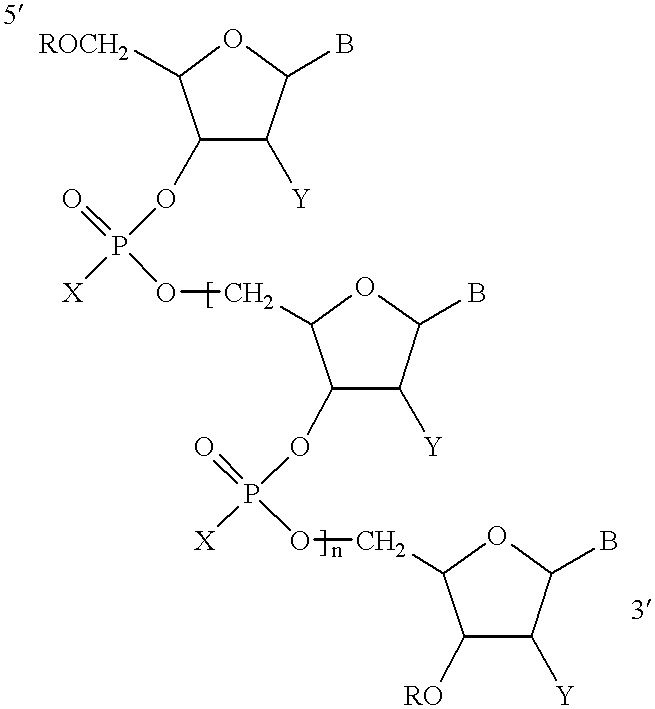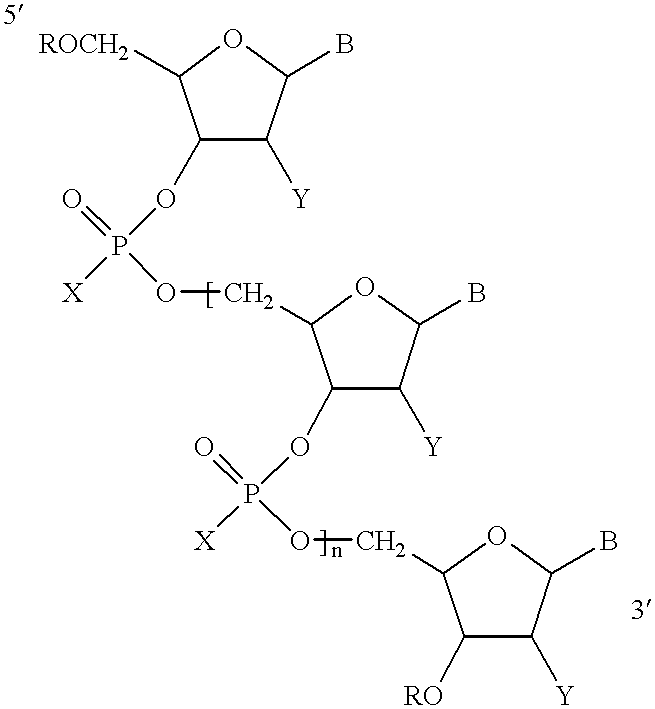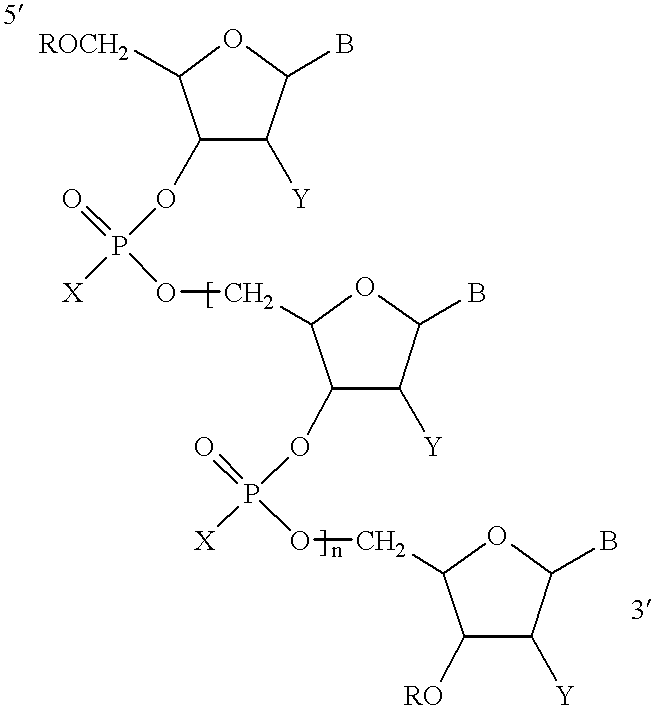Antisense oligonucleotide compositions targeted to angiotensin converting enzyme MRNA and methods of use
an angiotensin converting enzyme and antisense oligonucleotide technology, applied in the field of antisense oligonucleotide compounds, can solve the problems of short lasting effect of these drugs, limiting their use, and pathological consequences, and achieves the effect of reducing, inhibiting, and/or reducing the target mrna sequen
- Summary
- Abstract
- Description
- Claims
- Application Information
AI Technical Summary
Benefits of technology
Problems solved by technology
Method used
Image
Examples
example 1
5.1 Example 1
Antisense Compositions Inhibit ACE Activity
Three different oligonucleotides represented by Formula I in which B was selected such that the base sequence of the oligonucleotide is according to SEQ ID NO:4, or SEQ ID NO:5 or SEQ ID NO:6 were tested for their ability to inhibit the expression of human ACE. Human umbilical cord endothelial cells (ECV304) were incubated with each oligonucleotide for two days. The cells were lysed using 0.5% Triton.RTM. solution. The cells were homogenized and the ACE was measured by the ACE activity assay disclosed in Neels et al., 1983. The data demonstrated that each of the oligonucleotides with base sequences according to SEQ ID NO:4, SEQ ID NO:5, or SEQ ID NO:6 were effective in inhibiting ACE expression.
5.2 Example 2
Therapeutic Efficacy of ACE Antisense Compositions
The present example describes methods for utilizing ACE-specific oligonucleotide compositions as therapeutics for hypertensive animals. These studies utilized the spontaneous...
example 3
5.3 Example 3
Long-Term Therapy Using ACE Antisense Compositions
Six SHR rats were tested using the ODN with the base sequence according to SEQ ID NO:1. For this study, SHR rats were implanted with telemetry devices to continuously record blood pressure from the aorta 24 h a day for several weeks. A baseline was established in each case for approximately 1 wk, then ACE-AS-ODN 100 .mu.g was injected i.v. and the effect on blood pressure and heart rate observed. The effect of the antisense began between 3-6 h by producing a reduction in blood pressure of 20-30 mm Hg. The results were consistent from rat to rat (n=5). The maximum decrease in blood pressure (-40 mm Hg) occurred within 9-12 h but blood pressure remained decreased to normotensive levels for over 60 h with a single dose.
The next test was repeated injection. One week after the first treatment, a second injection with the same dose (100 .mu.g i.v.) was given. Repeated injections showed that the blood pressure was again reduced...
example 2
shows the effectiveness of ACE antisense (9-mer, 3 mg / kg) injected i.v. in SHR in groups of 7 rats (FIG. 2). There was on average, a 16.+-.3 mmHg drop in blood pressure from a baseline average of 169 mmHg and the duration of effect lasted, on average, 15.+-.4 days. From this experiment we conclude that ACE antisense will reduce blood pressure significantly in a model of hypertension. Secondly, the effect is long-lasting and the antisense could be injected as infrequently as once a week or once every 10 or 15 days.
In summary, these animal data demonstrated that an oligonucleotide comprising a contiguous base sequence according to SEQ ID NO:1, or 9 consecutive sequences based on SEQ ID NO:1 was an effective antihypertensive agent: a single injection (0.3 mg / kg) was effective for 3-4 days, a single injection (3 mg / kg) was effective for a mean of 15 days. Importantly, heart rate was not affected, and administration of the ODN was very well tolerated by the animal, with no apparent side ...
PUM
| Property | Measurement | Unit |
|---|---|---|
| temperature | aaaaa | aaaaa |
| diameters | aaaaa | aaaaa |
| diameters | aaaaa | aaaaa |
Abstract
Description
Claims
Application Information
 Login to View More
Login to View More - R&D
- Intellectual Property
- Life Sciences
- Materials
- Tech Scout
- Unparalleled Data Quality
- Higher Quality Content
- 60% Fewer Hallucinations
Browse by: Latest US Patents, China's latest patents, Technical Efficacy Thesaurus, Application Domain, Technology Topic, Popular Technical Reports.
© 2025 PatSnap. All rights reserved.Legal|Privacy policy|Modern Slavery Act Transparency Statement|Sitemap|About US| Contact US: help@patsnap.com



